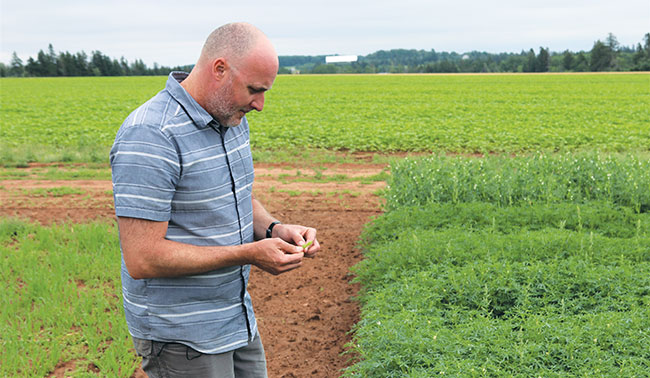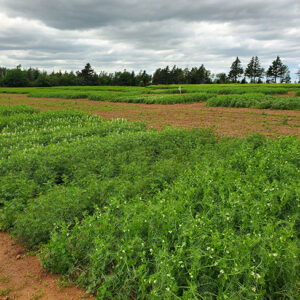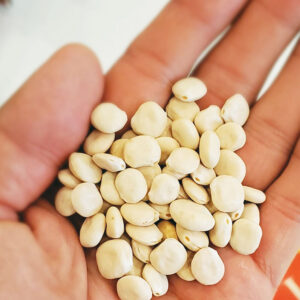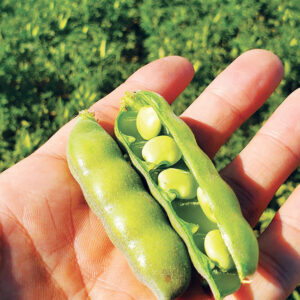
Features
Pulses
A promising new pulse for Eastern Canada
Sweet white lupin is in development as a pulse crop option for the east.
June 6, 2023 By Julienne Isaacs
 Aaron Mills inspects a lupin pod.
All photos courtesy of Agriculture and Agri-Food Canada.
Aaron Mills inspects a lupin pod.
All photos courtesy of Agriculture and Agri-Food Canada. Move over, soybeans: there’s a new pulse in town.
Sweet white lupin is a highly nutritious, edible pulse crop more commonly grown in Europe that, thanks to new investment and research, may soon find a place in eastern Canadian rotations.
At Agriculture and Agri-Food Canada’s Charlottetown Research and Development Centre, research scientist Aaron Mills is testing new varieties of Lupinus angustifolius (narrow-leafed sweet blue lupin), which is used for feed, and Lupinus albus (sweet white lupin), a food crop.
“At this point, we’re doing a variety evaluation and we’re using commercial field varieties as a benchmark,” says Mills. “We usually have half a dozen or maybe eight sweet white lupins and about six narrow-leaf lupins that we’re [testing].”
Mills and his colleagues at the research centre had done some work with lupins six or seven years ago, trying to establish some basic agronomy and assessing whether lupins could be a good fit on the coast. “We’re always looking for crops that could potentially fit here,” he says.
Last year, Mills was approached by Lupin Platform, an Alberta-based company that is developing a closed-loop, vertically integrated lupin value chain in Western Canada, to conduct more targeted evaluations of improved varieties.
The Charlottetown trials are part of a three-year research project Lupin Platform is running across the country; similar trials are underway in B.C., Alberta and Ontario.
The company is in the seed multiplication stage for several high-yielding European varieties and has already secured export markets for feed lupin, according to its website.
Mills says the crop isn’t grown at all yet in Eastern Canada. “We’re really in the developmental phase of this crop,” he says. “There was some work done in the 1980s, [but] there were issues with the crop reaching maturity. The climate has changed significantly since the 1980s, and the varieties have improved significantly, so we’re trying it again.”
So far, Mills says lupin appears to be a good fit for coastal conditions. The plants like cool weather and have performed well in well-drained soils.
Rotation-wise, sweet white lupin matures later than peas but before soybeans, meaning farmers have time to take it off. Lupin also comes off early enough for farmers to be able to seed a cover crop, and leaves residual nitrogen that the cover crop can use.
A powerhouse snack food
Sweet white lupin is cultivated across the Mediterranean region, as well as in eastern Europe, Africa and South America. Out of their pods, lupin seeds are large and creamy yellow in colour. In Greece, lupin seeds are eaten raw; in Egypt, they’re brined. In some places, they’re ground into flour and used as an additive to wheat flour.
Lupin could be considered a superfood due to its high protein and dietary fibre and low starch content, according to Lupin Platform, which also says the seeds contain three times more plant protein than quinoa, three times more fibre than oats and three times more iron than kale.
From an agronomic standpoint, the crop doesn’t present any unusual challenges. Mills says disease resistance has been an issue in the trials, but no more so than is typical under high moisture and high humidity. Just as with any other crop on the East Coast, an aggressive fungicide regime will be necessary, he says.
“The ultimate challenge with any crop is finding a market, but it sounds like there are market opportunities for this as a plant-based protein source,” adds Mills. “Market access is a challenge with every crop, but I think there is potential. With soybeans, the oil content tends to be too high so they’re not as desirable as a protein source, but peas and lupin have lower oil content.”
Producers are interested in the crop, he says. “I’ve gotten calls from people who previously grew them and they told me what the issues were, and I reached out to some people who I knew had tried lupin from the 1980s, and they said maturity was the biggest problem they had with the crop. [But] I think we’ve got that sorted.
“If the company is able to provide seed and forward-contract what’s produced, I think it bodes well for the industry.”


